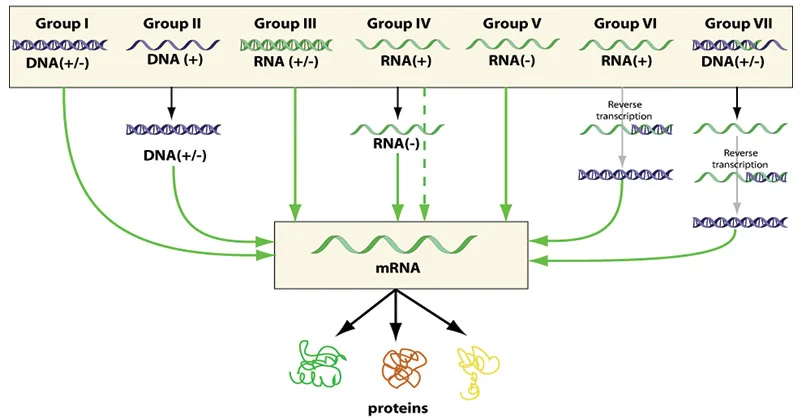Table of Contents
Introduction
- RNA viruses are a type of virus that have RNA as their genetic material instead of DNA.
- RNA viruses are found in a variety of organisms including animals, plants, and phages.
- In this essay, we will focus on the RNA viruses that infect animals and the different types of RNA genomes that exist among them.
Class IV RNA Viruses
- Class IV RNA viruses have genomes that can directly serve as mRNA, which means that it can be translated into viral protein immediately after infection.
- These viruses have a simple replicative cycle and are able to produce viral proteins immediately.
Class V RNA Viruses
- The genome of class V RNA viruses serves as a template for mRNA synthesis.
- The RNA genome is transcribed into complementary RNA strands, which then serve as both mRNA and templates for the synthesis of additional copies of genomic RNA.
- All viruses that use RNA as a template for mRNA transcription require RNA synthesis, which is carried out by a viral enzyme that is not present in most cells.
- This enzyme is packaged inside the viral capsid along with the genome during viral self-assembly.
Retroviruses (Class VI)
- Retroviruses, which belong to class VI, have the most complicated replicative cycles among animal RNA viruses.
- These viruses are equipped with an enzyme called reverse transcriptase, which transcribes RNA templates into DNA.
- This creates an RNA-DNA information flow, which is the opposite of the usual direction.
- One of the most medically important retroviruses is the human immunodeficiency virus (HIV), which causes acquired immunodeficiency syndrome (AIDS).
- HIV and other retroviruses are enveloped viruses that contain two identical molecules of single-stranded RNA and two molecules of reverse transcriptase.
The Replicative Cycle of HIV
- The replicative cycle of HIV is typical of a retrovirus.
- After HIV enters a host cell, its reverse transcriptase molecules are released into the cytoplasm, where they catalyze the synthesis of viral DNA.
- The newly made viral DNA then enters the cell’s nucleus and integrates into the DNA of a chromosome.
- The integrated viral DNA, called a provirus, remains a permanent resident of the cell’s genome and never leaves it.
- The host cell’s RNA polymerase transcribes the proviral DNA into RNA molecules, which can serve as both mRNA for the synthesis of viral proteins and as genomes for the new viruses that will be assembled and released from the cell.
Conclusion
In conclusion, RNA viruses that infect animals have a variety of RNA genomes, each with its own unique replicative cycle. From simple replicative cycles in class IV viruses to the complex replicative cycle of retroviruses, RNA viruses have the ability to produce viral proteins and replicate themselves in unique ways. The study of RNA viruses and their replicative cycles is important in understanding their role in disease and how they can be effectively controlled.
